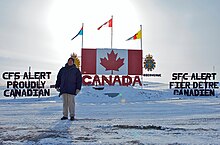CFS Alert
[6] Alert, then in Canada's Northwest Territories, was first settled April 9, 1950, when the first staff for the Joint Arctic Weather Station (JAWS) arrived and began construction.
In 1956, the Royal Canadian Air Force (RCAF), which was expanding its presence throughout the high Arctic with the construction of the Distant Early Warning Line radar network, established a building uphill from the Department of Transport's JAWS station to house "High Arctic Long Range Communications Research", or signals intelligence operations.
In 1957, Alert Wireless Station was conceived as an intercept facility to be jointly staffed by personnel from the Royal Canadian Navy (RCN) and the RCAF.
The station became a key asset in the global ECHELON network of the US-UK-CAN-AUS-NZ intelligence sharing alliance, with Alert being privy to many secret Soviet communications regarding land-based and sea-based ICBM test launches and many operational military deployments.
[1] Only six persons are now responsible for actual operations, and control of the facility was passed to DND's Information Management Group following the disbanding of CF Communications Command with force restructuring and cutbacks in the mid-1990s.
With Canada's commitment to the global war on terrorism following the September 11, 2001 terrorist attacks in New York City and Washington, D.C., CFS Alert has received renewed and increased funding to expand its SIGINT capabilities.
As of 13 April 2006[update] the Canadian Broadcasting Corporation reported that station heating costs had risen, leading the military to cut back on support trade positions by using private contractors.
